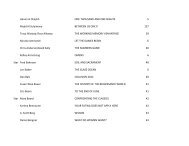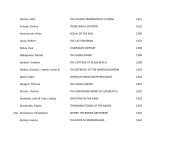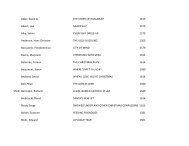nonfiction
nonfiction
nonfiction
You also want an ePaper? Increase the reach of your titles
YUMPU automatically turns print PDFs into web optimized ePapers that Google loves.
“Pale on characterization, dependent on<br />
plot and urban myths, this ‘gust’ is more of a light breeze.”<br />
from a gust of ghosts<br />
only of established professionals such as Wendelin Van Draanen<br />
and Todd Strasser, but of young writers who may not be as familiar.<br />
Additionally, the authors sample some of these young wordsmiths’<br />
work, which, although it stops the narrative flow, gives readers<br />
both a taste of their material and the feeling that this is something<br />
that’s achievable. The tone of the book is positive and self-help-y,<br />
but the advice is straightforward and practical. It includes quizzes,<br />
writing exercises to loosen up the brain and a handy section on further<br />
resources as well as a (too) short glossary of terms that all professional<br />
writers should know. Because it’s aimed at word slingers<br />
of all types of material and genres, some which the authors define<br />
and explain, the information is by necessity somewhat general and<br />
superficial, and writers seeking to work in specific genres will have<br />
to do further research.<br />
Part instructional, part inspirational, this writing<br />
primer is a good first stop for budding young scribes. (Nonfiction.<br />
8-12)<br />
A GUST OF GHOSTS<br />
Harper, Suzanne<br />
Greenwillow/HarperCollins (320 pp.)<br />
$16.99 | Jun. 1, 2012<br />
978-0-06-199610-8<br />
Series: The Unseen World of Poppy<br />
Malone, 2<br />
Life is hard when you think like a scientist<br />
and your parents are ghost hunters.<br />
Graveyard visits are nothing new to<br />
Poppy Malone and her siblings—twin<br />
brother, older sister and 5-year-old brother. They’re accustomed<br />
to moving from one place to another as their parents attempt to<br />
document ghostly apparitions and other paranormal incidents.<br />
When Poppy unknowingly “invites” a troupe of ghosts into<br />
their house, she seizes the opportunity to capture them on film<br />
and save her parents’ grant funding from being cut off. But, how<br />
to get rid of them The ghosts are stock characters: an older<br />
Shakespearean actor, a lone, heartbroken cowboy, two bossy<br />
women, a mischievous boy and even a dog. While the opening<br />
is chaotic and fairly predictable, hijinks ensue, and Poppy’s scientific<br />
explanations add a touch of reality. Pale on characterization,<br />
dependent on plot and urban myths, this “gust” is more of<br />
a light breeze.<br />
Second in a preteen series of spooky stories, the lure<br />
of ghosts will attract readers, particularly those who have<br />
read the first one (A Gaggle of Goblins, 2010). (Fantasy. 8-12)<br />
DOGS OF THE WORLD<br />
Kit and Willy’s Ultimate<br />
Guidebooks to Everything<br />
Helm, Zebedee<br />
Illus. by Helm, Zebedee<br />
Pucci/Trafalgar (32 pp.)<br />
$14.99 | Jun. 1, 2012<br />
978-0956028433<br />
A little boy named Kit and his dachshund<br />
Willy are the narrators of this<br />
seriously flawed British import written in the style of a child’s<br />
illustrated school report about dogs.<br />
Kit wears a 10-gallon hat and declares that he is “a cowboy<br />
from Montana in the good ol’ USA.” A short text is combined<br />
with clever spot illustrations of Kit and Willy introducing 13 different<br />
dog breeds with hand-lettered labels and speech balloons<br />
(complete with corrected spelling errors). Problematic text<br />
and negative racial stereotyping are present in the narration<br />
and illustrations for two breeds. In the description of Afghan<br />
hounds, the text states that because of the war, “everyone is<br />
too busy fighting to take their Afghans for walks, so they feel<br />
quite sorry for themselves.” The illustration shows a character<br />
resembling a cartoon-style Native American shooting at Kit<br />
(in a tank) with a bow and arrow. The pages on Pekingese dogs<br />
include a stereotypical cartoon of an emperor with a conical<br />
hat and long pigtail as well as a cook chasing a dog with a meat<br />
cleaver. The text asserts that “some people in China eat dogs”<br />
so “if you are a Chinese dog then maybe you should think about<br />
moving anywhere else.”<br />
Think about buying something else. (Picture book. 4-8)<br />
FLIRTING IN ITALIAN<br />
Henderson, Lauren<br />
Delacorte (336 pp.)<br />
$17.99 | $10.99 e-book | PLB $20.99<br />
Jun. 12, 2012<br />
978-0-385-74135-4<br />
978-0-375-98452-5 e-book<br />
978-0-375-98999-5 PLB<br />
Child of Nordic/Scottish parents,<br />
Violet—short, dark, curvy—feels like<br />
one of a kind until she discovers her uncanny resemblance to<br />
the Italian girl depicted in a 1790 portrait.<br />
Tracing the painting’s provenance to Castello di Vesperi<br />
in Tuscany, Violet wheedles her mother into sending her to<br />
Villa Barbiano, whose formidable owner, Catia, offers summer<br />
instruction in the Italian language, art and art history. Joining<br />
Violet are working-class Kelly, another Brit, and two rich<br />
American girls: blonde Paige and African-American Kendra.<br />
Cultures clash, but strife recedes as the girls unite against the<br />
unspeakable Elisa, Catia’s daughter, in pursuit of hot Italian<br />
boys, beginning with Elisa’s brother, Leonardo. Violet sets her<br />
sights on handsome Luca, whose family owns Castello di Vesperi.<br />
The plot finally thickens halfway through, when Violet’s<br />
resemblance to Luca’s family is discovered and their burgeoning<br />
romance interrupted by attempts on her life. Slapdash execution,<br />
an undisciplined, rambling style and often-senseless plot<br />
(why doesn’t plucky Violet simply ask her doting mother if she’s<br />
adopted) mark this series opener from the author of the Scarlet<br />
Wakefield mysteries. Fortunately, Violet’s character eventually<br />
develops: Abandoning her generically breathless persona, Violet<br />
morphs into a funny, caustic observer, comparing and contrasting<br />
teen cultures and mores—American, British, Italian.<br />
For readers willing to abandon plot logic and go with<br />
the flow, there are compensations. (Mystery romance. 12 & up)<br />
THE SCARY PLACES<br />
MAP BOOK<br />
Seven Terrifying Tours<br />
Hennessy, B.G.<br />
Illus. by Madrid, Erwin<br />
Candlewick (32 pp.)<br />
$15.99 | Jun. 1, 2012<br />
978-0-7636-4541-0<br />
In the same vein as the author’s Once Upon a Time Map Book<br />
(1999 with foldouts; flat edition 2004), more map-reading practice<br />
in the guise of an ocean voyage and six tours of spooky landscapes<br />
or locales.<br />
Hennessy starts by inviting armchair travelers to step aboard<br />
the Ghostly Galleon in a Mediterranean “Haunted Harbor” and<br />
later to join such tour guides as Gruesome Gus for a trip around<br />
the “Western Terror-tories,” and Hercules as he revisits the<br />
sites of selected labors in the “Land of Mythical Monsters.”<br />
For each expedition, the author lays out an itinerary with map<br />
coordinates in stages measured by “mermaid leagues,” “zombie<br />
miles” or like appropriate units. Readers can trace each route on<br />
uncluttered painted aerial or cutaway views that fill about two<br />
thirds of their spreads. These come with number/letter grids<br />
(in a lightweight typeface that makes it hard to distinguish a “1”<br />
from an “I”), compass roses, keys and large (superfluous) labels<br />
on major features—as well as various mermaids and monsters,<br />
plus tiny black cats or other not-exactly-concealed items to<br />
spot. Madrid’s digitally produced illustrations include full-page<br />
“close ups” that, for some reason, differ in detail from their corresponding<br />
iterations on the maps.<br />
Not particularly challenging—nor, since the settings<br />
are conventional enough that even younger children will<br />
probably find them familiar, particularly scary either. (Picture<br />
book. 7-9)<br />
NOTHING SPECIAL<br />
Herbach, Geoff<br />
Sourcebooks Fire (304 pp.)<br />
$9.99 paperback | May 1, 2012<br />
978-1-4022-6507-5<br />
Over the course of a cataclysmically<br />
awful trip, Felton Reinstein journals for<br />
his girlfriend about breakthroughs in his<br />
familial relationships.<br />
Last year, at 15, nerdy Felton hit a<br />
growth spurt and became Stupid Fast<br />
(2011), a track star and a football star. This year, with his girlfriend<br />
Aleah in Germany, Felton must deal with his fame and<br />
the possibility that his younger brother Andrew could be falling<br />
apart. Andrew has convinced their mother to let him go to band<br />
camp, but Felton discovers that Andrew, usually the sane member<br />
of the family, has in fact run away to Florida. An impromptu<br />
road trip with erstwhile best friend Gus turns up surprising<br />
reasons for Andrew’s escape. Herbach’s sophomore effort is<br />
impenetrable to those who have not read his first, due to a complete<br />
lack of character introductions. The conceit of telling the<br />
tale of the road trip while on a different trip is a convoluted<br />
one that buries the heart of this potentially touching tale in a<br />
flabby, confusing construct few readers will enjoy. Felton’s voice<br />
is frenetic, often annoyingly self-deprecating and repetitious;<br />
his fans are the only ones who need apply.<br />
If Herbach had avoided playing narrative games and<br />
just run with his story, this might have been something special.<br />
(Fiction. 12 & up)<br />
SLITHER SLIDE,<br />
WHAT’S OUTSIDE<br />
Hilb, Nora; Shapiro, Simon &<br />
Shapiro, Sheryl<br />
Illus. by Hilb, Nora<br />
Annick Press (32 pp.)<br />
$8.95 paperback | PLB $19.95<br />
May 1, 2012<br />
978-1-55451-386-4<br />
978-1-55451-387-1 PLB<br />
Similar to Hilb’s Wiggle Giggle Tickle Train (with co-author<br />
Sharon Jennings and photographer Marcela Cabezas Hilb,<br />
2009), this imaginative romp shows kids using nature to fuel<br />
their creative play through all the seasons of the year.<br />
Left-hand pages feature beautiful stock photos of (mostly)<br />
nature that encompass the four seasons—a blossoming tree,<br />
rainfall, a growing pumpkin and a snowplow at work are among<br />
the 13. Right-hand pages showcase Hilb’s watercolors of children<br />
patterning their play after nature. A photo of a frog appears<br />
opposite two children jumping over a log, a rainbow prompts a<br />
coloring session and some geese flying overhead lead the children<br />
to use toy horns to copy their calls. But it is the addition of<br />
the Shapiros’ rollicking verses that truly make this an all-around<br />
enjoyable collaboration. The waterfall spread is a standout, the<br />
856 | 15 april 2012 | children’s & teen | kirkusreviews.com |<br />
| kirkusreviews.com | children’s & teen | 15 april 2012 | 857






